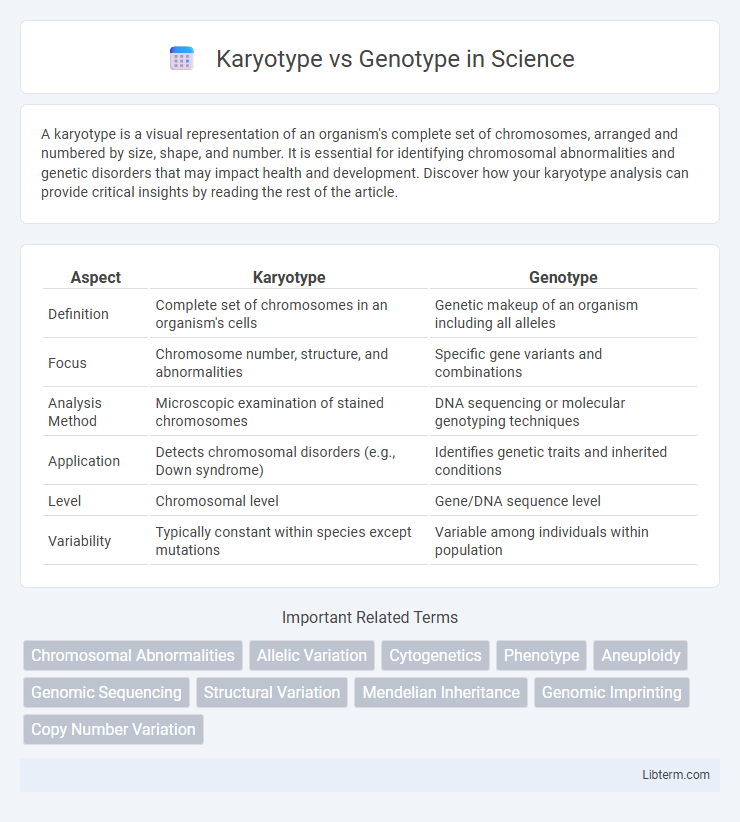A karyotype is a visual representation of an organism's complete set of chromosomes, arranged and numbered by size, shape, and number. It is essential for identifying chromosomal abnormalities and genetic disorders that may impact health and development. Discover how your karyotype analysis can provide critical insights by reading the rest of the article.
Table of Comparison
| Aspect | Karyotype | Genotype |
|---|---|---|
| Definition | Complete set of chromosomes in an organism's cells | Genetic makeup of an organism including all alleles |
| Focus | Chromosome number, structure, and abnormalities | Specific gene variants and combinations |
| Analysis Method | Microscopic examination of stained chromosomes | DNA sequencing or molecular genotyping techniques |
| Application | Detects chromosomal disorders (e.g., Down syndrome) | Identifies genetic traits and inherited conditions |
| Level | Chromosomal level | Gene/DNA sequence level |
| Variability | Typically constant within species except mutations | Variable among individuals within population |
Understanding Karyotype: Definition and Significance
A karyotype refers to the complete set of chromosomes in an organism, organized and displayed in a standardized format to analyze chromosome number, size, and structure. It plays a crucial role in identifying chromosomal abnormalities such as trisomy 21 in Down syndrome or monosomy X in Turner syndrome. Understanding karyotypes aids in genetic diagnosis, prenatal screening, and research related to hereditary diseases and chromosomal disorders.
Genotype Explained: Basics and Importance
Genotype refers to the genetic constitution of an organism, encompassing all inherited genes that influence traits and biological functions. It is the fundamental blueprint encoded within DNA sequences, determining an individual's hereditary potential beyond observable characteristics. Understanding genotype is crucial for fields like genetics, medicine, and evolutionary biology, as it helps predict disease risk, guide personalized treatments, and study genetic variation within populations.
Key Differences between Karyotype and Genotype
Karyotype refers to the complete set of chromosomes in an organism, visually displayed during metaphase, revealing chromosomal number and structure abnormalities. Genotype represents the specific genetic makeup of an individual, encompassing all gene variants inherited from both parents that influence traits and disease susceptibility. While karyotype analysis detects large-scale chromosomal changes, genotype analysis identifies variations at the DNA sequence level within genes.
Methods for Analyzing Karyotypes
Karyotype analysis primarily involves methods such as G-banding, fluorescence in situ hybridization (FISH), and spectral karyotyping (SKY) to visualize chromosome structure and identify abnormalities. These techniques allow for the detection of chromosomal deletions, duplications, translocations, and aneuploidies by staining or labeling specific DNA sequences on chromosomes during metaphase. Unlike genotype analysis, which uses DNA sequencing or SNP genotyping to study genetic variation at the nucleotide level, karyotype analysis provides a macroscopic view of chromosome architecture crucial for diagnosing genetic disorders and cancers.
Techniques Used for Genotype Analysis
Genotype analysis techniques primarily include polymerase chain reaction (PCR), DNA sequencing, and microarray analysis, which enable detailed examination of specific gene variants and genetic mutations. PCR amplifies targeted DNA regions for mutation detection, while next-generation sequencing provides comprehensive genomic data at high resolution. Microarrays allow simultaneous analysis of thousands of genetic markers, facilitating large-scale genotype profiling and association studies.
Applications of Karyotyping in Medicine
Karyotyping is extensively used in medicine to diagnose chromosomal abnormalities such as Down syndrome, Klinefelter syndrome, and Turner syndrome by visually analyzing chromosome number and structure. This technique aids in prenatal screening, fertility assessments, and identifying genetic causes of miscarriages. Unlike genotype analysis that examines specific DNA sequences, karyotyping provides a broader overview of chromosomal organization critical for clinical diagnosis and treatment planning.
Genotype's Role in Genetic Research
Genotype represents the specific genetic makeup of an organism, providing crucial data for identifying inherited traits and disease susceptibilities in genetic research. This detailed genetic blueprint enables researchers to analyze variations in DNA sequences, facilitating advancements in personalized medicine and gene therapy. Understanding genotype is essential for mapping genotype-phenotype correlations and uncovering the molecular basis of hereditary conditions.
Karyotype vs Genotype in Diagnosing Genetic Disorders
Karyotype analysis provides a visual representation of an individual's chromosome number and structure, making it essential for diagnosing chromosomal abnormalities such as Down syndrome, Turner syndrome, and Klinefelter syndrome. Genotype refers to the specific allelic composition of genes and is critical for identifying mutations at the DNA sequence level, enabling diagnosis of single-gene disorders like cystic fibrosis and sickle cell anemia. Combining karyotype and genotype testing enhances diagnostic accuracy by detecting both large-scale chromosomal anomalies and subtle genetic mutations in genetic disorders.
Limitations of Karyotype and Genotype Analyses
Karyotype analysis is limited by its resolution, detecting only large chromosomal abnormalities and missing small genetic mutations or single nucleotide variants. Genotype analysis, while more precise in identifying specific genetic variants, may not capture complex structural variations or epigenetic factors influencing gene expression. Both techniques require complementary methods like sequencing or microarray for comprehensive genetic diagnosis.
Future Prospects: Advances in Genetic Analysis
Future prospects in genetic analysis reveal that karyotyping will increasingly integrate with high-throughput sequencing technologies to detect structural chromosomal abnormalities alongside precise nucleotide variations. Advances in genotype profiling enable comprehensive mapping of individual genetic variants, fostering personalized medicine and targeted therapies. Emphasis on combining karyotype imaging with genotypic data enhances diagnostic accuracy and predictive modeling in genomics.
Karyotype Infographic

 libterm.com
libterm.com